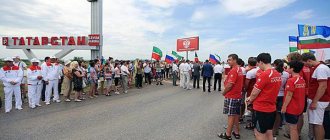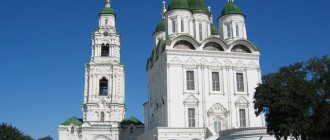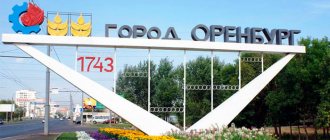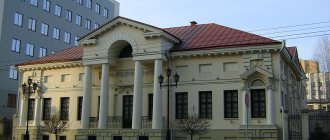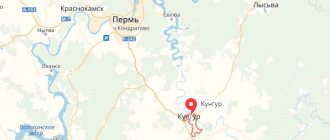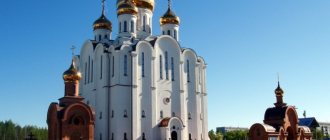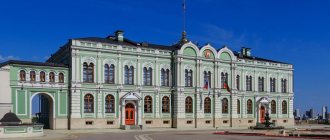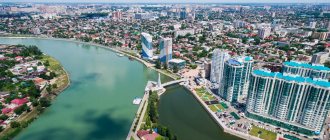Founded: 1574
City Day is celebrated
on June 12
.
In 2021, due to the pandemic, mass events in honor of the city day are canceled or may be postponed
Monument to the national hero of Bashkortostan Salavat Yulaev by sculptor S.D. Tavasiev (1967)
Ufa
– Russian city, capital of the Republic of Bashkortostan. The city is located on the banks of the Belaya River, at the confluence of the Ufa and Dema rivers, on the Pribelsky ridge-undulating plain, 100 km west of the ridges of the Bashkir (Southern) Urals.
Early history
the vicinity of Ufa goes back to the distant past, during the Old Stone Age (Paleolithic). The date of the city's foundation has been the subject of debate for centuries. Already in the Paleolithic era (20-30 thousand years ago) there were settlements of primitive people here. The Ufa hills and rivers are a magnificent natural defensive structure, which is why ancient fortified settlements are known on the so-called Ufa Peninsula.
In 1574, 17 years after the voluntary acceptance of Russian citizenship by the Bashkir tribes and the entry of Bashkiria into Russia, to strengthen the south-eastern borders of Russia, at the confluence of the Ufa and Belaya rivers, the Kazan governor Mikhail Alexandrovich Nagim founded the Ufa fortress, to the east of which there was not a single city until the Pacific Ocean.
Cathedral of the Nativity of the Virgin Mary (Photo: Bembikrat, ru.wikipedia.org) From a fortified city, Ufa gradually grew into the center of the region in the 17th and 18th centuries. In the 18th century, Ufa was part of the Kazan province, was the center of the Ufa province, and was part of the Orenburg province. Since 1802, Ufa became a provincial city with the residence of the governor and provincial institutions, and since 1865 - the center of the Ufa province.
In June 1922, the Autonomous Bashkir SSR, created in 1919, was annexed to the Ufa province, and Ufa became its capital.
Industry in Ufa appeared in the 19th century. The opening of regular navigation along the Belaya River in 1870 and the construction of the Samara-Zlatoust (now Kuibyshev) railway (1888-1892) gave a new impetus to the development of the city. Railway and ship repair shops, sawmills, and steam mills appeared in the city. By the end of the 19th century, there were about 30 factories and factories, and trade in bread and meat flourished.
At the end of the 1920-30s, the city began to develop rapidly, and gross industrial output increased 16 times. The Ufa Industrial Plant and light and food industry enterprises came into operation. During the first five-year plan, the Ufa Engine Plant and a thermal power plant were built. After the discovery of Bashkir oil in 1939, the Ufa Oil Refinery was built.
The Friendship Monument was founded in 1957 in honor of the 400th anniversary of the voluntary entry of Bashkiria into the Russian state.
During the Great Patriotic War,
dozens of industrial enterprises, some government agencies and research institutes were evacuated to Ufa from the western regions of the USSR.
In the post-war years, due to the expansion of oil production in the republic, new oil refineries were built in Ufa: the second (Novo-Ufimsky), and a few years later - the third. Ufa has become the largest oil refining center in the Volga region and the Urals. At the same time, the chemical industry and mechanical engineering developed in the city.
By Decree of the President of the Russian Federation dated July 2, 2021, Ufa was awarded the honorary title of Russian Federation for the significant contribution of city residents to achieving Victory in the Great Patriotic War of 1941–1945, ensuring uninterrupted production of military and civilian products at industrial enterprises, and for the massive labor heroism and dedication shown. Federation " City of Labor Valor"
».
Today Ufa
- the largest oil refining center in the Volga region and the Urals, a major transport hub, scientific, cultural and religious center of Russia. The main religious denominations are Islam and Orthodox Christianity. Ufa is the center of the Ufa and Sterlitamak diocese of the Russian Orthodox Church. Ufa is also the seat of the central authorities and the mufti of the Central Spiritual Administration of Muslims of Russia and the European CIS countries.
Congress Hall
Interesting facts
: The tallest building in the city is the office of Uralsib Bank. This is a 26-story building with a height of 100.5 meters. Ufa is the greenest million-plus city in Russia. There are 202 square meters of green space per resident. In Ufa, Svoboda Street ends with the “Dead End of Svoboda”.
Day of the city
celebrated in Ufa on June 12, simultaneously with two other significant holidays: Russia Day and Salavat Yulaev Days.
History of Ufa
The city of Ufa is located in the valley of the Belaya River at the confluence of the Ufa and Dema rivers. People have noticed this area for a long time. Ancient settlements from the Mesolithic, Neolithic, Bronze and Iron Ages have been found on the territory of Ufa. It is interesting that the Bashkirs in ancient times believed that the Idel (Volga) river begins at the confluence of the Ak-Ideli (Belaya) and Kara-Ideli (Ufa) rivers. The name “Ufa,” according to one version, could come from the ancient Turkic word “uba” - “hill, mountainous area.”
After the capture of Kazan by Ivan the Terrible by 1557, the main part of Bashkiria voluntarily became part of the Russian state. Bashkiria was governed from Kazan, but due to the great distance it was not easy. In 1573, the Bashkirs turned to Ivan the Terrible with a request to build a fortress on their land.
In May 1574, a detachment of Moscow archers under the leadership of the boyar Ivan Nagogo (he was a close relative of the wife of Ivan the Terrible) landed on the right bank of the Belaya River near the mouth of Ufa. It is Ivan Nagogo who is considered the first builder of Ufa. On the bank of the Belaya on Mount Turatau (“fortress mountain”), a wooden fortress, Trinity Church, huts and outbuildings were built. The settlement was protected due to the features of the relief.
In 1586, the rapidly growing settlement was already called a city. Ufa became an important Russian outpost in this part of the Urals and served as a defensive line. It was the center of the Ufa district. The first governor was Mikhail Nagoy. When the borders of Russia expanded to the east, Ufa lost its defensive function and began to turn into a craft and merchant city, maintaining administrative significance. In 1708, the Ufa district became the Ufa province (first as part of the Kazan and then the Orenburg provinces). Since 1781, Ufa has been the center of the Ufa governorate, and since 1796 - the center of the Orenburg province. In 1865, Ufa became the center of the Ufa province.
In May 1759, a tragedy occurred in Ufa. Lightning struck the Mikhailovskaya Tower of the Ufa Kremlin. The old wooden Kremlin and 210 houses were consumed by fire. The Kremlin was no longer restored; the administrative center of the city arose in its place. Since the 18th century, the largest horse fair in the region has been held in Ufa.
In 1773-74, during the Peasant War, Ufa was able to withstand the siege of Pugachev’s troops under the command of Chika (I.N. Zarubina) twice. I.I.’s army came to the aid of the besieged city. Mikhelson, there were fierce battles near Ufa. Chika was captured and thrown into a dungeon under the bell tower of the Smolensk Cathedral. After 8 months, Salavat Yulaev also ended up there.
In 1788, a Muslim spiritual administration headed by a mufti arose in Ufa. In 1789, the first public school opened. In 1799, the Orenburg-Ufa diocese was formed. In 1836, the first provincial library was founded. In 1864, a museum was opened at the men's gymnasium, gradually increasing its collection and changing buildings.
Shipping was opened in 1859. In 1890, the Samara-Zlatoust railway passed through Ufa.
During the Civil War, Ufa became one of the centers of the white movement. Over the course of two years, power changed hands several times, and there were bloody battles. On June 9, 1919, the Kolchakites were finally defeated. For carrying out the Ufa operation, division commander V.I. Chapaev received the Order of the Red Banner of Battle. In 1922, Ufa became the capital of the BASSR, and since 1991 - the Republic of Bashkortostan.
In the 1930s, the Ufa Oil Refinery was built in the city, which by 1940 had become the country's largest enterprise of this type.
In 1956, the city of Chernikovsk was annexed to Ufa. In 1989-90, a major man-made disaster occurred in Ufa - as a result of an accident at the Ufakhimprom production plant, a large amount of phenol entered the city’s water supply. As a result of the phenolic disaster, mass poisoning of city residents occurred; drinking tap water was prohibited for several months.
The famous writer S.T. spent his childhood in Ufa. Aksakova. At the beginning of the 20th century, A.A. taught at the Guzmania madrasah. Validi is the leader of the Bashkir national movement, orientalist-Turkologist, Ph.D. In 1918, the Czech writer Jaroslav Hasek worked in Ufa. In 1941, in Ufa, the future writer S.D. was born into a family of evacuees. Dovlatov, and in 1944 - the future violinist, conductor V.T. Spivakov. Originally from Ufa, Alexander Matrosov became famous for his feat during the Great Patriotic War. In the 1980-90s, Ufa became one of the centers of rock culture. The group “DDT” was formed here, led by Yuri Shevchuk, and singer Zemfira Ramazanova is also from here.
The population of Ufa, according to the 2010 census, is 1,038,100 people. This is the most spacious and greenest million-plus city in Russia. The main part of the city is located within the so-called “Ufa Peninsula”.
General information
To the question “Ufa – which region of Russia?” The answer is often wrong. Often the region is named after the name of the main city. But “Ufa region” today is an outdated concept. It was abolished back in 1953. At the same time, the Bashkir Autonomous Soviet Socialist Republic was formed. Therefore, the question itself about which area is incorrect. The city of Ufa is the capital of the Republic of Bashkortostan.
The Ural metropolis is one of the largest populated areas in the country. Ufa on the map of Russia is located in the Urals and ranks eleventh in terms of the number of inhabitants. As of January 1, 2015, the number exceeded one million one hundred thousand people. Another three hundred thousand people live in the Ufa agglomeration.
Ufa occupies a prominent place on the map of Russia. This is a major center of almost any industry - economic, sports, scientific, transport.
The city is divided into seven administrative districts.
The settlement was founded in 1574.
The total area is almost 708 square kilometers.
The population density is 1562 people per square kilometer.
Fifth time zone Greenwich Mean Time. Regarding Moscow, the difference is plus two hours.
Telephone code: +7 347.
Postal code: 450000 – 450 999.
Vehicle code: 02, 102.
There are more than eighty branches of large banks, as well as representatives of brokerage companies.
Sights of Ufa
The main symbol of Ufa (and the entire Republic of Bashkortostan) is a monument to Salavat Yulaev , a national Bashkir hero glorified in Soviet times. It was installed in 1967 at the highest point above the Belaya River - on Cherkalikhina Mountain. The author of the sculpture is S.D. Tavasiev. The sculpture weighs 40 tons and is said to have been the largest in the USSR at that time. Salavat Yulaev is shown on a risen horse, rushing forward. The dynamism is enhanced by a high pedestal and a well-chosen installation location. It is especially beautiful here at sunset.
Nearby is the Congress Hall (Zaki Validi St., 2), built in 2005-07. This is one of the most striking monuments of modern architecture in Ufa. The most impressive is the 179-meter-long glazed façade with Bashkir ornaments. On Salvat Yulaev Alley, near the building, the largest fountain complex . Nearby you can see the art object “UFA” in the form of corresponding blue letters with an ornament.
In 2015, the area near the Congress Hall was covered with multi-colored paving slabs and a national ornament. An amphitheater has also been created here. There is an asphalt running track along the perimeter of the square. Sometimes mass events take place in this place. In the part of the square closest to the river there are yurts from the Vatan ethno-village . The complex consists of seven yurts, which reflect the entire identity of the region: folk crafts, customs, details of traditional Bashkir life, there is a catering area with national cuisine, an open library, and a lecture hall.
of the embankment was opened in 2015 . Construction of the second and third phases is currently underway.
Opposite Salavat Yulaev Square (across the road) is Gafuri Square , where you can see the art objects “Open Book”, “Tree of Love”, “Bee”.
Off to the side, 600 m east of Congress Hall, an old brick tower is visible on the mountain. It was built in 1899-1900 as a water tower for the first Ufa water supply system. In 1957, the tower found a second life. An astronomical station for observation and control of artificial Earth satellites moved here from the Pedagogical University. A large telescope was installed in the tower to observe solar eclipses and satellites. A dome was installed on the roof. In 1976, the observatory was closed. Now the building is empty.
The historical center of Ufa with numerous architectural monuments is located east of the Congress Hall.
One of the most picturesque cultural buildings in Ufa is the building of the Bashkir Academic Drama Theater named after Mazhit Gafuri (Zaki Validi, 34). Officially, this theater was founded in 1919 in Sterlitamak, and in 1922 it was transferred to Ufa. The theater building is located on the site of the Resurrection Cathedral, which was dismantled in the 1930s. It is an architectural monument. In front of the building there is a monument to M. Gafuri. a Memorial House-Museum of Mazhit Gafuri in Ufa (Gogol St., 28). The people's poet of Bashkortostan lived here in 1923-34.
Next to the drama theater there is a park named after Lenin - one of the oldest in Ufa. Created in 1867-72 at the suggestion of Governor S.P. Ushakov (for which he received the name Ushakovsky). It was the main vacation spot for residents of pre-revolutionary Ufa. The city's first fountain was installed here, and the Mir summer cinema operated. After the 1917 revolution, it was renamed Freedom Park. Those who died during the revolution and the Civil War are buried here, and a memorial has been erected. In 1934, the national poet of Bashkiria M. Gafuri was buried in the park. After the Great Patriotic War, it was renamed in honor of A.M. Matrosov (there is a monument in his honor here), and in the 1980s it was called the park named after. IN AND. Lenin.
Closer to the Belaya River, near the southeastern edge of the park at the intersection of Sovetskaya and Tukaev streets, stands the former Governor's House . The building was built in 1832-38 in the style of Russian classicism according to the design of architects A.D. Zakharov and A.A. Gopius. Later an office and gallery were added. In 1861-67, the first Ufa civil governor G.S. lived and worked here. Aksakov. Here was the administrative center of the city. Now the building houses the Ministry of Health of Bashkortostan.
From the governor's house, Sofiushkina Alley , leading to Aksakov's house. As stated on the memorial plaque, this is the only alley of the classical type in Ufa. It was founded by Sofia Aksakova, the wife of Governor Grigory Aksakov.
The alley passes by the first Ufa cathedral mosque (52 Tukaev St.), which was built in 1830. This is a stone building with one minaret. In the evening, the mosque is illuminated. At the end of the 19th century, a relic came here - several hairs from the beard of the Prophet Muhammad. The Guzmaniya madrasah operated at the mosque. In Soviet times it was the only functioning mosque in Ufa. Nearby (on Volnova Street, 21) there is a memorial house-museum of A.E. Tyulkina . The People's Artist of the BASSR lived in this house in 1922-80.
Memorial House-Museum of S.T. Aksakov (4 Rasuleva St., tel.) was opened in 1991 in a house from the mid-18th century in which the Aksakov family lived. The famous writer spent his childhood here. A description of the house is in the book “The Childhood Years of Bagrov the Grandson.”
Opposite the house on the banks of the Belaya River is the garden of Salavat Yulaev . The rotunda in the garden is beautifully illuminated. There is a view of the Belaya River and the bridge across it.
Aksakov’s garden in Ufa . It is located between Pushkin and Novomostovaya streets. This is the first garden in the city, but it was private (called the Blokhin Garden). Here you can find a stele in memory of the estate of the Aksakov family and the sculptural composition “The Scarlet Flower”.
Nearby is the building of the former Ufa provincial zemstvo government (Tsyurupy street, 12). It is noteworthy that in the summer of 1900 V.I. met with the Social Democrats here. Lenin. On the street Pushkina, 108 – building of the Mariinsky Women's Gymnasium , built in 1860. Now this building houses gymnasium No. 3. In front of it there is a monument to Maxim Gorky.
Not far from Aksakov's garden there is the Khudaiberdin House-Museum (Novomostovaya St., 20, tel.) - an excellent example of wooden architecture. Sh.A. Khudaiberdin is a writer, a prominent party and government figure, and a participant in the establishment of Soviet power in Bashkortostan.
From this house you can see the Church of the Savior Not Made by Hands (October Revolution Street, 37a). In the past, it outwardly resembled the Kazan Cathedral in St. Petersburg. It was founded in 1824 and consecrated in 1845. Its facade was decorated with a semicircular colonnade of 36 columns, and there were bell towers along the edges. In 1929, the church was closed and rebuilt, and has been operating again since 2004. The colonnade has only been partially restored.
It is interesting to walk along October Revolution Street, which consists almost entirely of old stone and wooden houses. Among them is the house of the miner Ivan Demidov (October Revolution Street, 57/1). It is considered the oldest house in Ufa and is an architectural monument of the mid-18th century. It is interesting that in May 1775 the future famous Russian commander A.V. stayed here. Suvorov. From here you can see the Ar-Rahim Mosque, which was still under construction during our visit to Ufa at the beginning of 2021.
Moving further along this street, you will come to the Friendship Monument . It was founded in 1957 and opened in 1965 in honor of the 400th anniversary of the voluntary entry of Bashkiria into Russia. It was built on the site of the oldest stone building in Ufa - the Trinity-Smolensk Cathedral, which stood on the territory of the Kremlin at the beginning of the 17th century, but was demolished in 1956. The monument looks like a composition of two female figures who sit half-turned to each other and hold out laurel wreaths - a symbol of peace. The figures represent Bashkortostan and Russia. Between them, the bas-relief shows a meeting of the Bashkirs and Russians, the exchange of letters. At the foot of the monument are the words “Glory to the great fraternal friendship of the Russian and Bashkir peoples.”
On the way to the street October Revolution you can see the plant management of I.I. Gutman, fire tower, mill I.K. Seldimir and other architectural monuments.
The beginning of Lenin street between st. Zaki Validi and Pushkin over the course of one block is a pedestrian alley of modern sculpture “ ArtTerria” . In 2016, 13 art objects about 2 m high were installed here. All of them are united by the theme: “Russia. Eurasian space: civilization and culture" and made of granite from the Mansurovsky quarry. Separately, it is worth noting the art object “Three Screws” . This is the nickname for the stylized name of the city in the Bashkir language.
Behind the “screws” on a parallel street you can see the building of the National Museum of the Republic of Bashkortostan (Sovetskaya St., 14, tel. 272-12-50). This is the largest museum in Bashkiria and one of the oldest in the country. Founded on April 23, 1864 under the Provincial Statistical Committee of the Orenburg Province. It is located in an architectural monument - in the building of the former Peasant Land Bank of the early 20th century; an extension was made to it in the 1940s. The museum has 35 exhibition halls dedicated to archeology (Bronze and Stone Age), history (XV-XXI centuries), ethnography of the Bashkir and other peoples of the republic (Udmurts, Mordovians, Mari, Ukrainians, Chuvashs, etc.), numismatics, nature of Bashkiria, etc. .d. The museum's funds include 140 thousand storage units of the main fund and 51 thousand storage units of the scientific and auxiliary fund. One of the most famous exhibits of the museum is a saber, which according to legend belonged to Salavat Yulaev.
At the corner of Lenin and Pushkin streets is the building of the Noble Assembly (Lenin St., 14). It was built in 1844-56 in the style of late classicism. It was two-story, and later a third floor was added. On the facade there is a stucco coat of arms of Ufa. In 1885, the Society of Lovers of Singing, Music and Dramatic Art settled in the building, where F.I. performed on May 6, 1891. Chaliapin (as an old servant in A.G. Rubinstein’s opera “The Demon”). , a monument to Chaliapin was erected in 2007 . The singer is depicted as very young, when his creative path was just beginning. In 1964, this building hosted a plenum of the Union of Composers under the leadership of composer D.D. Shostakovich. Today the building is occupied by the Ufa State Institute of Arts.
Across the road is the Bashkir State Opera and Ballet Theater (Lenina 5/1). It is located in the former people's house of S.T. Aksakov, which was founded in September 1909 on the 50th anniversary of the writer’s death. It was built with donations from the population according to the design of the architect P.P. Rudavsky. The brick building is designed in an eclectic spirit with a predominance of neoclassical elements. In this building in 1923 M.I. performed. Kalinin at the IV All-Bashkir Congress of Soviets. In 1953-55, the outstanding dancer of the 20th century, Rudolf Nureyev, began his career here. The Theater Museum has been operating since 1993.
Alley runs along Pushkin Street , where you can see monuments to Aksakov and Pushkin.
In 2008, a monument to the Bashkir composer Z.G. Ismagilov . a fountain “Seven Girls” installed in Theater Square . It appeared in 2015. The idea is based on the famous Bashkir legend about seven similar sisters who escaped from captivity and preferred death in the waters of a deep lake to returning to captivity. In the evening the fountain is illuminated, and in winter it is decorated with New Year's illumination.
Nearby is one of the earliest surviving secular buildings in the city - Gostiny Dvor (Verkhnetorgovaya Square, 1). It was built in the middle of the 19th century and was completed by 1866. It is a one-story building in the classicist style with an arcade running along the entire perimeter. Nowadays, the building is used for its intended purpose - it is a trade and business complex. Next to Gostiny Dvor there is a beautiful building of the trading house of Ivanov and Nobel (Lenin St., 5/4). The building was built in 1912 by architect K.A. Guskov, commissioned by the Ufa merchant I.E. Ivanova. Acquired in 1916 by the Nobel Brothers Petroleum Production Partnership to house the main office.
Nearby, in Lenin Park at the corner of Lenin and Kommunisticheskaya streets, a very original monument to V.I. Lenin . The leader of the proletariat sits with a book in his hand, leaning slightly forward, and behind him rises a tall stele with a globe on top. The marble monument was made in 1924 according to the design of D.N. Larionov in the village of Mramorskoye (Sverdlovsk region). It is considered one of the most unusual monuments to Lenin. The square itself was laid out in 1925; for this purpose, a gardener from the Tauride Garden was invited from Leningrad.
Diagonally from the square there is the Main Post Office building (Lenin St., 28), in front of which you can see the “Kilometer Zero” sign . The corner building opposite (Lenin St., 7) is the main building of the former City Government .
A monument to the educator and poet M. Akmulla was erected in 2008 at the corner of October Revolution and Sovetskaya streets . Sculptor V.A. Janitor, architect D.M. Magafurov. Here Akmullah is depicted, who is resting at a spring after a long journey, and a boy and a girl come up next to him and listen to his story. The figures of the poet and the boy are shown sitting on large white stones. Willows are planted next to the monument, and in the summer there is a fountain simulating a spring. Nearby is Mayakovsky Square with a monument to this poet (corner of Kommunisticheskaya - Tsyurupy streets). According to some reports, he once visited Ufa.
In Ufa, a wooden house has been preserved in which V.I. lived. Lenin and N.K. Krupskaya in 1900. The House-Museum of V.I. is opened there. Lenin (Dostoevsky St., 78, tel.). Nearby you can see a monument to surveyors, nearby there is an area of two fountains with art objects “I love Ufa” and “Figure of a man and a woman.”
Near the Republican Library (Kirova St., 1) there is a large-scale monument to Mustai Karim , a famous Bashkir poet, writer and playwright. Some of the characters from his books seem to come to life in the monument.
On the corner of Kommunisticheskaya and Karl Marx streets is the house of officers of the Ufa garrison (Kommunisticheskaya St., 43). The building was built in the eclectic style in 1904 as an apartment building for the Ufa merchant A.M. Parshina (also known as the Big Siberian Hotel). The first floor was occupied by shops, the second and third - “Siberian rooms”, there was also a restaurant, a billiard room, and a concert hall. In 1918, the Ufa Directory - the Provisional All-Russian Government - worked here. In Soviet times, the Red Army Club was located here, since 1926 - the House of the Red Army, since 1939 - the House of Officers. In January 1919, the Czech writer Jaroslav Hasek spoke in this building, on November 4 of the same year - the leader of the Indian national liberation movement M. Barakatullah, and on April 12, 1932 - the Soviet writer Alexander Fadeev. In memory of these events, memorial plaques were installed on the building.
Across the road is the apartment building of G.K. Nagel with a beautiful turret (Kommunisticheskaya St., 39). The first President of Estonia, Konstantin Päts, stayed in this house during his exile in the 1940s.
Further down the street is the building of the Astoria Hotel (Karl Marx St., 25). Nearby (Karl Marx St., 23) is TSUM , a former store of the Karimov and Shamgulov brothers.
At 86 Pushkin Street there is a beautiful house of P.I. Kosterina . The building was built in 1907 according to the design of the famous architect A.A. Shcherbachev for Samara grain merchant P.I. Kosterin and his companion, merchant S. A. Chernikov. The cost of building the mansion was a huge amount for those times - 30 thousand rubles. The inscription on the memorial plaque recalls that from June 9 to June 25, 1919, the political department of the 25th Infantry Division, headed by Commissioner D.A., was located here. Furmanov. Nowadays it is one of the most beautiful buildings in Ufa. It is an architectural monument. It houses the Customs House of the Republic of Bashkortostan. Near the bus station, the Kosterins’ country house from 1890 (Richard Sorge, 15) has also been preserved.
In the former mansion of merchant E.A. Ponosova-Mollo houses the Museum of Archeology and Ethnography of the Institute of Ethnological Research of the UC RAS (Karl Marx St., 6). The building was built in 1910 at the expense of merchant S.S. Manaev for the design of the architect K.A. Guskova. It was the first example of the historicist style in Ufa; it combines elements of Baroque and Renaissance. The museum opened in 1980. This is one of the largest repositories of archaeological, ethnographic and anthropological collections collected during scientific expeditions. Unfortunately, it’s not easy to get into it: only on weekdays by appointment as part of an excursion group.
On a parallel street there is the Bashkir State Art Museum named after. M.V. Nesterov (Gogol St., 27). It was created on the basis of a collection donated by the famous artist Nesterov. The museum opened to the public in 1920. Located in the house of the timber merchant M.A. Laptev, and a large modern museum building was built nearby. In front of the museum building is a monument to Mikhail Nesterov.
On the house on the street. Gogol, 56 there is a memorial plaque reminding that the future famous Russian writer Sergei Dovlatov , who was born in Ufa during the evacuation of his parents during the Great Patriotic War, lived there in 1941-44. The house is adjacent to the Bashkir State Philharmonic (Gogol St., 58). The building was built around 1915 in the neoclassical style with elements of oriental flavor (pointed arched windows on the second floor). At first there was a synagogue here.
You can also take a walk in the park of culture and recreation named after. Yakutova (Lenin St., 65/3). The park in this place was created at the beginning of the 20th century. In 1918 it was named after the revolutionary I.S. Yakutova. Railway workers and Red Guards who died in battles against the White Guard ataman Dutov were buried here. During Soviet times, the cemetery adjacent to the park was destroyed and the Church of John the Baptist was demolished, due to which the territory of the park expanded. The decoration of the park is Soldiers' Lake. In 1953, a 2 km long children's railway was launched. There are many monuments and art objects in the park. In front of the entrance to the park there is a bronze monument “The House of the Marten” . This animal is a symbol of Ufa. In the past, merchants, when conducting trade, paid with kuns - marten skins. The popular comic name of the monument is “Where is the salary?!”
And a little about the churches of Ufa. The oldest surviving one is Pokrovskaya (Mingazheva St., 4). It was built by merchant D.S. Zhulbin and priest I.A. Breev. The bell tower was built by Prince Urakov and consecrated in 1823. The church was closed in 1941, but reopened in 1957. On the street Bekhtereva, 2 St. Sergius Cathedral , built in 1868, has been preserved. This is the only temple in the city that was not closed during Soviet times.
On the street Kirov, 102 is the Cathedral of the Nativity of the Virgin . This is the most spacious Orthodox church in Ufa, which can accommodate up to several thousand people. The height of the cathedral is 21 m, the bell tower is 47 m. The church was founded, according to various sources, in 1889 or 1901. Consecrated in 1909. In Soviet times, a hospital, aircraft workshops, and a cinema were located here. Pink Italian, white Greek and yellow Pakistani marble, Italian serpentinite, and South African granite were used in the decoration of the walls and floors. The walls and ceilings are painted.
In the northern part of the city, it is worth visiting the Lyalya-Tulpan mosque-madrasse (Komarov St., 5). It was built in 1998. It has an unusual shape. Architect V. Davletshin based the project on the tulip, a symbol of spring.
Nearby is Victory Park with monuments, the eternal flame and the Museum of Military Glory. The architectural ensemble of Chernikovka, created in Soviet times, is also interesting. In the Sipailovo microdistrict you can visit the Kashkadan park (Marshal Zhukov St., 31) with the lake of the same name.
In the trans-river part of the city on the street. Bashkirskaya in 2007, a monument to governor M.A. Naked . On the pedestal it is written: “To the founder of Ufa, governor Nagy Mikhail Alexandrovich, from grateful Ufa residents.” However, not all researchers agree with this statement.
Perhaps the most interesting informal attraction of Ufa is the adits . It is rare to find such underground structures under any city. Developments near the city were actively carried out in the 19th-20th centuries, gypsum was mined. The entrance to one of the adits can be found in the middle part of the steep right bank of the Ufa River in the VDNKh area. The path to it goes from the ferry crossing (at forks you need to keep the paths to the right). The length of the adit is 2620 m. It is a labyrinth in which it is easy to get lost. The entrance to the dungeon was closed with iron bars and brickwork, but the diggers opened them. The adit impresses with its impressive volumes. The adit is not ventilated, which is why the air inside is heavy. There were cases when people inside suffocated. You should be careful when visiting, and it is better not to walk far from the entrance.
If you go from the adit further along the path and climb the mountain, you will find yourself on Bald Mountain . In ancient times, there was a settlement here called Devil's. From the edge of the hill there is a beautiful view of the Ufa River and the surrounding area. Through the Green Grove sanatorium you can exit into the city.
The longest cities in Russia: TOP-10
A few years ago, experts compiled their ranking of the longest cities in the country. The cartographers chose the following as the main criterion for evaluating their analysis: the shortest route that can be taken through the entire city. Moreover, this route should be laid exclusively along the streets.
It is worth noting that for their analysis, experts chose only million-plus cities. The TOP 10 longest cities in Russia according to GIS 2 looks like this (the length of the route in km is indicated in brackets):
- Moscow (112.0).
- St. Petersburg (102.1).
- Samara (69.3).
- Volgograd (64.5).
- Ufa (54.3).
- Perm (48.8).
- Omsk (48.2).
- Novosibirsk (46.2).
- Yekaterinburg (45.6).
- Kazan (44.5).
Sights of Ufa on the map
Ufa has many parks and is considered one of the greenest cities. It is better to visit it in summer. However, it’s good here for the New Year too, as ural experts are convinced of. The city is beautifully decorated with New Year's illumination.
Ufa leaves a pleasant impression. This is a beautiful city with wide streets (to match the capital) and perfectly preserved old pre-revolutionary buildings. It is surrounded on both sides by large rivers – the Belaya and the Ufa. You can also feel the national flavor here. Signs and plaques are usually in Russian and Bashkir (and in some places also in English). Ufa definitely deserves to be here!
Descriptions and addresses of all Ufa museums can be found in a separate review.
Pavel Raspopov
See also:
- Objects of cultural heritage of the city of Ufa (list of architectural monuments)
- Suzdaltsev Victor. Pictures with the beauties of Bashkiria
- Blue Lake (Zyangyar Kul) near Ufa
- M. Somov. Description of Ufa (1864)
Sources: Wikipedia Dobreitsina L.E., Sannikova T.O. Historical cities of the Urals. Part 2. Historical cities of the Southern Urals. - Ekaterinburg, 2013. Ufa - 2GIS
Support Uraloved
The longest city in Russia: several contenders
Russia, like any other country in the world, has its own record-breaking cities. For example:
- Moscow is the largest city (both in area and population);
- Derbent is the oldest (more than 2500 years old);
- Magas is the smallest and youngest;
- Tyrnyauz is the “highest” (located at an altitude of 1100 meters above sea level).
But naming the longest city in Russia, it turns out, is not so easy. You can find conflicting data in different sources. But most of them indicate that the longest city in Russia is Sochi.
True, if you look at a satellite map, you can see that Sochi is, in fact, a series of separate resort villages. They stretch along the Black Sea coast for 145 kilometers. That is why some experts, not without reason, claim that the longest city in Russia is Volgograd. Its total length is almost 100 kilometers. Supporters of this version hint that Volgograd is characterized by continuous urban development (without territorial breaks, as in Sochi).
One way or another, the list of the longest cities in Russia may look like this:
- Sochi.
- Volgograd.
- New Urengoy.
- Vladivostok.
- Ufa.
It is worth noting that determining the length of a particular city is a rather difficult task. After all, there are several completely different ways and approaches to measuring this parameter.
Theaters
Bashkir Academic Drama Theater named after the Bashkir poet Mazhit Gafuri
- Bashkir Academic Drama Theater named after the Bashkir poet Mazhit Gafuri, which is located on the site of the Resurrection Cathedral, which was dismantled in the 30s of the twentieth century. It is an architectural monument.
- The Opera and Ballet Theater began construction in 1909, when the 50th anniversary of the death of the writer Aksakov was celebrated. The building is made of brick, built with donations from townspeople, in the eclectic style fashionable at that time (a mixture of styles) with a predominance of antiquity.
Museums
- The National Museum of Bashkortostan is one of the oldest and largest in the republic. Opened in 1864, located in the former building of the Peasant Land Bank. The construction dates back to the beginning of the twentieth century; in the 40s an extension was made to it. The museum has halls of archeology, history, ethnography of all peoples living on the territory of the republic, a total of 35 halls. The saber of Salavat Yulaev is kept there.
- Art Museum named after M.V. Nesterov, an artist who donated his painting to the museum from which the collection was collected. The opening of the museum took place in 1920 in the house of the merchant Laptev. Currently, a modern museum building has been built nearby.
- The memorial house-museum of the writer Aksakov was organized in 1991 in an old house of the eighteenth century, where the writer’s family lived.
- The house-museum of the writer Khudayberdin, which is an amazing example of wooden architecture.
- Memorial house-museum of the people's poet of Bashkiria Mazhit Gafuri, who lived in the city of Ufa from 23 to 34 of the last century.
House-museum of the writer Khudaiberdin
Monuments
- The emblem of Bashkiria and the city of Ufa is the monument to Salavat Yulaev, the Bashkir people's hero. It was installed in 1967 on Cherkalikhina Mountain above the Belaya River. A rider on a risen horse that rushes forward. The monument is made of metal and weighs more than 40 tons, but from the outside it gives a flying, weightless impression.
- The Friendship Monument was opened on the 400th anniversary of the annexation of Bashkiria to the Russian State. The monument depicts two women sitting half-turned to each other, personifying Russia and Bashkortostan. They hold out the symbol of peace, laurel wreaths. On the bas-relief between the women there are figures of Bashkirs and Russians exchanging letters.
Flag
The flag of Ufa is made in the form of a rectangular panel. The aspect ratio is 2:3. It consists of two horizontal stripes: the upper one is white, 7/10 wide of the same size of the panel, and the lower one is green. The first contains a marten in the center of a natural brownish-brown color.
The artistic composition was approved on September 6, 2007 (decision No. 26/4). Included in the State Heraldic Register of the Russian Federation under No. 3243.
Coat of arms
The coat of arms of Ufa is presented in the form of a French shield. On a silver background there is a picture of a marten running on green ground. The animal has a natural brownish-brown color. The marten is facing the left side of the viewer. In the official drawing, you can see decorative elements on the “ground” - small T-shaped figures. They symbolize grass.
The coat of arms goes back to the historical version. It is allowed to frame it with a wreath of golden oak branches, leaves and acorns, over which a ribbon of the same metal is placed. At the top there is an inscription: “1574”.
The artistic composition is included in the State Heraldic Register of the Russian Federation under No. 3000. The author is S. Gilyazetdinov. Adopted by decision of the Ufa City Council of October 12, 2006 No. 16/4 (as amended on March 31, 2010). The description of the frame of the coat of arms was approved on May 17, 2007.

